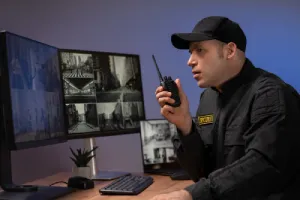Recording Incidents in Real Time
In the Security Control Room (SCR), every second matters, and so does every record you make. Real-time recording of incidents is not just about writing notes, it’s about capturing accurate, factual information as events unfold. Your logs become official evidence, support investigations, and demonstrate that your control room operates to the highest professional standards under SIA, ACS, BSI, and NSI frameworks.
When incidents occur, the control room log is the heart of accountability. It tells the story of what happened, who was involved, and how your team responded. The quality of your record can be the difference between a smooth investigation and a compliance failure.

Why Real-Time Recording Matters
Accurate, real-time recording ensures transparency, accountability, and legal protection, both for you and your organisation. UK security regulations, including BSI BS 7499 and NSI Guarding Gold Standards, emphasise precise record-keeping as a cornerstone of professional conduct.
Key Benefits of Real-Time Recording:
Evidence Integrity: Logs made at the moment are considered more reliable in audits, investigations, and court proceedings.
Operational Clarity: Real-time updates help all teams make faster, informed decisions.
Accountability: Demonstrates that actions were compliant with SIA and ACS codes of conduct.
Audit Readiness: Accurate logs show your organisation meets quality standards during inspections.
Statistic to Know: According to ACS compliance reviews, over 70 percent of control room audit failures are linked to incomplete or delayed incident logs.
What to Record in Real Time
A good incident log captures both the facts and the flow of events, what happened, when, and what was done about it.
| Information to Record | Why It’s Important |
|---|---|
| Exact Time and Date | Establishes an accurate timeline for accountability and evidence. |
| Incident Type | Helps classify severity and determine the right response procedures. |
| People Involved | Identifies witnesses, responders, or affected individuals. |
| Actions Taken | Documents every step for review, audit, or investigation. |
| Communications Made | Shows who was informed and when, ensuring compliance with reporting protocols. |
| Outcome or Status | Indicates how the incident was resolved or escalated. |
Tip: If it’s not written down, it didn’t happen. Always assume your report could be reviewed by auditors, management, or even legal authorities.
Real-World Example: The Power of Accurate Logging
During a night shift, an SCR Operator noticed suspicious movement on CCTV. They logged every action, time of detection, officer dispatch, updates from patrol, and when the police arrived. Later, that detailed record helped police identify a repeat offender and proved that the control room acted exactly according to SIA operational standards.
Without that accurate log, the operator’s professionalism would have been hard to prove, and the site’s compliance could have been questioned.
Tip: Your pen, or keyboard, can be as powerful as your radio.
Best Practices for Recording in Real Time
Real-time recording can be fast-paced, but consistency is key. Follow these professional practices to maintain clarity and compliance:
Log Immediately: Don’t wait until the incident ends, write as it happens.
Use Clear, Concise Language: Keep notes factual and free from emotion or personal opinions.
Follow the 5Ws: Record Who, What, Where, When, and What’s being done.
Standardise Entries: Use approved formats or templates as required by BSI and NSI guidelines.
Check Spelling and Grammar: Poorly written logs can create confusion during audits.
Include All Communications: Record every call, message, or instruction, including time and person contacted.
Stay Objective: Write only what you see or can confirm, not assumptions.
Tip: Type fast, think faster, but always stay accurate. A rushed or vague log is almost as bad as no log at all.
Common Mistakes to Avoid
Even skilled operators can make errors under pressure. Avoid these pitfalls to maintain professionalism and compliance:
Forgetting to note exact times of actions or communications.
Writing vague descriptions like “officer dealt with it” instead of specifying what happened.
Failing to update the log once new information is received.
Using personal opinions (“looked suspicious”) instead of objective facts (“male seen loitering near gate for 3 minutes”).
Neglecting to record when the incident was closed or handed over.
Consequence: Incomplete or inaccurate logs can lead to compliance breaches under ACS and BSI standards, disciplinary action, or reputational damage during audits.
Using Technology to Improve Accuracy
Modern SCRs rely on digital systems that streamline real-time reporting and ensure consistency.
Incident Management Software: Allows instant data entry and auto time-stamping for accuracy.
Integrated CCTV Logs: Links footage directly to event records for stronger evidence.
Voice Recording Systems: Capture verbal communication for review and training.
Tip: Always double-check that your entries are saved and time-stamped correctly. Technology helps, but accuracy still depends on you.
Real-World Reflection
In one UK logistics site, a delayed log entry caused major confusion. An operator waited until the end of an incident to record details, missing key times and updates. During a later review, it was unclear when actions were taken, leading to audit questions and a temporary non-compliance mark under ACS assessment.
The lesson was clear: real-time means right now, not later. Recording as events unfold builds trust, transparency, and protection.
Staying Accountable and Professional
Recording incidents in real time is far more than an administrative duty, it’s a reflection of your professionalism and composure under pressure. Every entry you make shows your ability to stay calm, factual, and compliant, even in fast-moving situations. How you record an incident defines the credibility of your control room and strengthens your organisation’s reputation for excellence.
Remember:
Your log is your voice when you’re not in the room. Write clearly, record accurately, and ensure every detail reflects the high standards of the SIA, ACS, BSI, and NSI. In every incident, you control the narrative, so make it professional, precise, and by the book.

